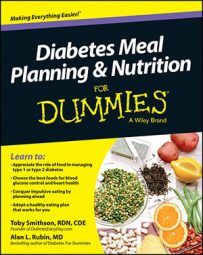It’s possible, with an early diagnosis and a strong commitment to lifestyle, to manage type 2 diabetes without medication. This course, however, isn’t commonly the case, and type1 diabetes can’t be managed without insulin. So, keeping blood glucose levels in balance almost always involves matching medication to your ingestion of carbohydrate foods. And both the volume and the timing of eating carbohydrate foods are important.
Everyone’s blood glucose levels go higher after eating carbohydrate foods because it takes time to release insulin and for insulin to do its work. The objective of managing diabetes medications and food is to blunt sharp rises in blood glucose levels, and to get levels back down in a way that’s close to a normal response.
When your diabetes treatment includes rapid acting or short acting (regular) insulin taken before a meal, matching medication with food can and should be done with some precision. That means people with type 1 diabetes, or those with type 2 who are taking these formulations of insulin, must know carbohydrates.
The relationship between insulin and carbohydrate food is best illustrated by your specific insulin to carbohydrate ratio (I:C ratio). That figure is usually expressed as 1 unit of insulin to compensate for a certain number of carbohydrate grams — 1:15, for instance, means 1 unit of insulin for every 15 grams of carbohydrate.
A meal that includes 45 grams of carbohydrate would require 3 units of insulin if 1:15 is your insulin to carb ratio. However, your insulin to carb ratio is very much an individual number for you, and your I:C ratio may be different than the I:C ratio for someone else, and may even be different for your breakfast than for your lunch or dinner.
Treating diabetes with rapid or short-acting insulin also requires adjustments. If your blood glucose level is in the normal range at mealtime, your I:C ratio is all you need. But, if your blood glucose is higher than normal, whether at mealtime or not, you need to apply a correction factor.
Your correction factor represents how much your blood glucose levels will drop — how many milligrams per deciliter (mg/dl) in the United States — if you take one unit of insulin without food. The number differs from person to person, and may be different according to the time of day.
The individualized numbers are never perfect, but where these insulin formulations are part of your treatment, matching the dose to your food is fairly accurate and extremely flexible.
Matching food and insulin always requires knowing your blood glucose level before you take the insulin. Overdosing results in dangerous low blood glucose levels (hypoglycemia), and under dosing leaves blood glucose above normal. Testing blood glucose before every meal and testing again two hours after your meal — called postprandial — helps you keep your I:C ratio and correction factors zeroed in.
Matching food and medication with this kind of precision doesn’t apply to other diabetes medications, including intermediate acting or long acting insulin formulations. Even diabetes pills that are taken at mealtime aren’t dose-adjusted based upon what you’re eating at that meal. However, it’s important to control carbohydrate consumption in a different way for optimal blood glucose control.
Your diabetes meal plan allocates your daily carbohydrate foods evenly, more or less, to each meal so that your daily dose of glucose from food doesn’t all come at the same time. Your meal plan also emphasizes that you get your carbohydrates from foods that are slowly digested, like beans and fruit, rather than from added sugars that can cause blood glucose levels to spike soon after eating.
Ultimately, the goal is to help you keep your blood glucose under control, and the benefits of blood glucose control are profound.

